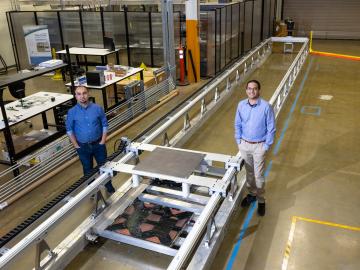
Filter News
Area of Research
- (-) Computer Science (1)
- (-) Energy Science (46)
- (-) Materials (44)
- (-) National Security (9)
- Advanced Manufacturing (2)
- Biological Systems (1)
- Biology and Environment (82)
- Biology and Soft Matter (1)
- Electricity and Smart Grid (1)
- Functional Materials for Energy (1)
- Fusion and Fission (7)
- Isotopes (3)
- Materials Characterization (1)
- Materials for Computing (9)
- Materials Under Extremes (1)
- Neutron Science (18)
- Nuclear Science and Technology (3)
- Quantum information Science (1)
- Supercomputing (42)
News Type
News Topics
- (-) Bioenergy (17)
- (-) Environment (36)
- (-) Exascale Computing (2)
- (-) Materials Science (34)
- (-) Mercury (1)
- (-) Polymers (7)
- 3-D Printing/Advanced Manufacturing (39)
- Advanced Reactors (7)
- Artificial Intelligence (15)
- Big Data (8)
- Biology (10)
- Biomedical (6)
- Biotechnology (2)
- Buildings (15)
- Chemical Sciences (15)
- Clean Water (5)
- Composites (5)
- Computer Science (28)
- Coronavirus (9)
- Critical Materials (1)
- Cybersecurity (17)
- Energy Storage (36)
- Fossil Energy (1)
- Frontier (2)
- Fusion (5)
- Grid (17)
- High-Performance Computing (10)
- Hydropower (1)
- Irradiation (1)
- Isotopes (8)
- ITER (1)
- Machine Learning (12)
- Materials (48)
- Mathematics (2)
- Microelectronics (1)
- Microscopy (15)
- Molten Salt (1)
- Nanotechnology (19)
- National Security (28)
- Neutron Science (18)
- Nuclear Energy (17)
- Partnerships (8)
- Physics (15)
- Quantum Computing (2)
- Quantum Science (3)
- Security (9)
- Simulation (2)
- Space Exploration (2)
- Summit (5)
- Transportation (25)
Media Contacts

Energy and sustainability experts from ORNL, industry, universities and the federal government recently identified key focus areas to meet the challenge of successfully decarbonizing the agriculture sector

Neuromorphic devices — which emulate the decision-making processes of the human brain — show great promise for solving pressing scientific problems, but building physical systems to realize this potential presents researchers with a significant

Ten scientists from the Department of Energy’s Oak Ridge National Laboratory are among the world’s most highly cited researchers, according to a bibliometric analysis conducted by the scientific publication analytics firm Clarivate.

A multidisciplinary team of scientists at ORNL has applied a laser-interference structuring, or LIS, technique that makes significant strides toward eliminating the need for hazardous chemicals in corrosion protection for vehicles.

Improved data, models and analyses from ORNL scientists and many other researchers in the latest global climate assessment report provide new levels of certainty about what the future holds for the planet

ORNL’s Zhenglong Li led a team tasked with improving the current technique for converting ethanol to C3+ olefins and demonstrated a unique composite catalyst that upends current practice and drives down costs. The research was published in ACS Catalysis.

Consumer buy-in is key to the future of a decarbonized transportation sector in which electric vehicles largely replace today’s conventionally fueled cars and trucks.

At the Department of Energy’s Oak Ridge National Laboratory, scientists use artificial intelligence, or AI, to accelerate the discovery and development of materials for energy and information technologies.

Oak Ridge National Laboratory was among an international team, led by Lawrence Livermore National Laboratory, who synthesized 108 elevated carbon dioxide, or CO2, experiments performed in various ecosystems to find out how much carbon is

Twenty-seven ORNL researchers Zoomed into 11 middle schools across Tennessee during the annual Engineers Week in February. East Tennessee schools throughout Oak Ridge and Roane, Sevier, Blount and Loudon counties participated, with three West Tennessee schools joining in.


